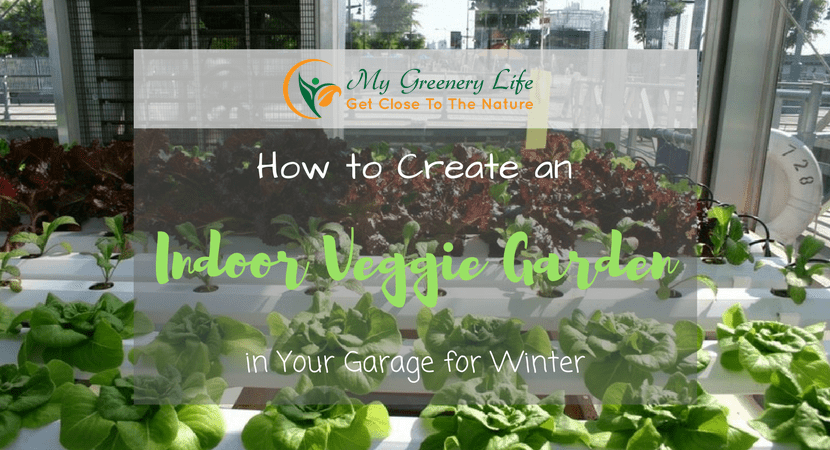Conventional gardening wisdom says that winter is an awful time to tend a garden as temperatures dropping below zero don’t provide the humidity that plants need to grow which also makes them susceptible to frost, not to mention that you’d most likely find your garden all blanketed with snow. That would be true of course, if you have an outdoor garden, but not so once you start gardening indoors. If you’re figuring out which part of your house would make for the perfect indoor garden, you might want to look into using your garage to grow veggies there that you can feast upon when you’re stuck with nothing else to do during a snowstorm or blizzard.
What Will You Need to Create an Indoor Veggie Garden in Your Garage for Winter?
Before you can start turning your garage into an indoor garden where you can grow your veggies for winter, here are some of the things you’ll need:
- Adjustable full-spectrum grow light stand
- Space heater
- Cool mist humidifier
- Portable fan
What Veggies Can You Grow in Your Garage for Winter?
Not all veggies can thrive indoors, and you wouldn’t want to attempt growing ones that are out of season either. The good news though is that there are winter veggies that can grow indoors, and here are some of them that you could raise for your indoor garden.
How Can You Create an Indoor Veggie Garden in Your Garage for Winter?
Now that you’ve gathered all the things and veggies you’ll need, you can start following these steps on how to create an indoor veggie garden in your garage for winter.
Get rid of all old junk in your garage.
You would have to clear out your garage of all your old junk first before you could start building an indoor veggie garden there. Hiring local junk removal is the best option, they will clear all your old junk and save your time, also help you to get rid of heavy items pretty easily, so you don’t have to waste time and money trying to buy or rent more equipment.
- All your old items that are still in usable condition can be donated, sold or pawned.
- Your other old items that aren’t in usable condition anymore has to be disposed of immediately.
Brighten up your indoor veggie garden with full-spectrum grow lights.
Carried by most home improvement stores, full-spectrum grow lights make for a great stand-in to sunlight, especially during winter season when sunlight isn’t as available.
● You would have to place your veggies in a full-spectrum grow light stand that allows you to adjust how much light each of them is receiving.
- For you to save electricity, you should consider turning on your full-spectrum grow lights at night.
- To quickly gauge the amount of time that your veggies are receiving artificial light, you can use an automatic timer to turn your full-spectrum grow lights on and off.
- You can turn off your full-spectrum grow lights during the day when the inside of your garage is receiving enough sunlight for your plants to grow.
Control the temperature and humidity levels of your indoor veggie garden.
Setting the right temperature and humidity levels in your garage helps ensure that the veggies growing in your indoor garden are thriving.
- You should use a space heater to control the temperature of your indoor veggie garden, but remember to keep the temperature just slightly above freezing.
- For either pepper or cherry tomato, you would have to make the temperature of your indoor veggie garden a bit hotter.
- You should also use a cool mist humidifier in your indoor veggie garden to prevent your veggies from succumbing to root rot and other fungal infections.
- For the humidified air in your indoor veggie garden to get evenly distributed across all your veggies, you should use a portable fan.

Consider plotting your indoor garden vertically.
Tending an indoor veggie garden shouldn’t pose too much of a problem once you try vertical gardening.
- Vertical gardening lets you grow more veggies in less space, and has become a favorite go-to approach for those who are pursuing gardening despite living in highly dense urban areas.
- Potatoes are one example of veggies you can grow in a vertical indoor veggie garden as planting them in towers or bags makes it easier for them to be harvested as opposed to the usual way of harvesting them wherein you have to dig deep underground.
Growing your veggies doesn’t have to stop every time winter is approaching. As long as you follow these steps, you can make your garage a lot more useful by raising veggies in there while waiting for winter to pass. Don’t forget to help you could insulate your garage door as well to keep the cold out.
George is a specialist when it comes to amarr doors online and garage doors. Working in the industry for over 20+ years he takes pride on helping his clients fulfill their needs when it comes to garage construction and finding the right size. In his spare time, he loves spending time with his family.
 George Anderson
George Anderson Last Updated on


Reply